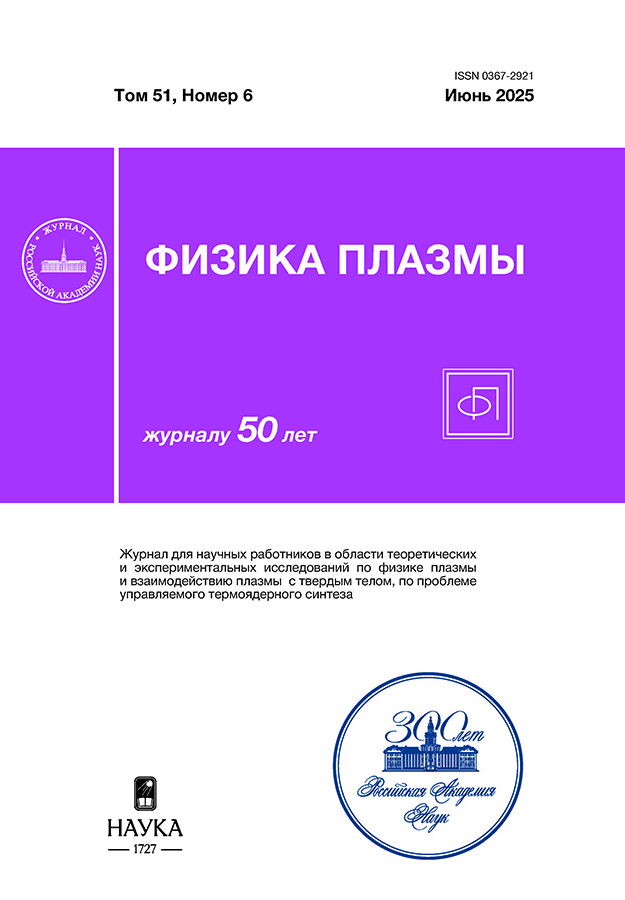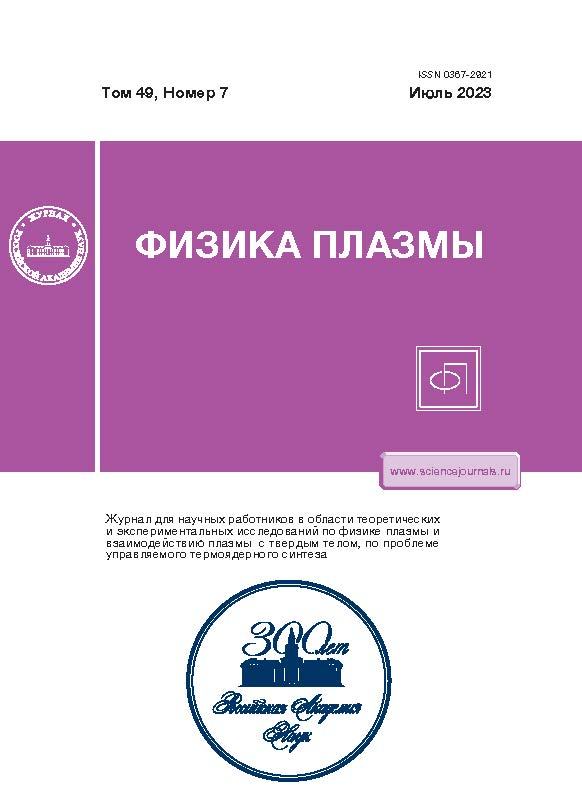Том 49, № 7 (2023)
ТОКАМАКИ
О формировании и стационарном поддержании пикированных профилей давления в турбулентной плазме токамаков
Аннотация
Рассмотрена теоретическая модель усиления пикированности радиального распределения тепловой энергии плазмы и повышения времени ее удержания за счет формирования профилей тока, обеспечивающих повышенную величину коэффициента запаса устойчивости \({{q}_{b}}\) на внешней границе плазмы. Развита модель формирования и стационарного поддержания пикированных профилей плотности тока, обеспечивающих поддержание равновесных состояний плазменного шнура с повышенной величиной \({{q}_{b}}\) и сохранением \({{q}_{0}} \approx 1\) на магнитной оси. Модель основана на значительном снижении тока \({{I}_{{ind}}}\), поддерживаемого индуктором, при одновременном включении центрального ЭЦР-нагрева и электрон-циклотронной генерации тока ECCD. Путем компьютерного моделирования самосогласованной эволюции турбулентной плазмы в условиях токамаков Т-10 и Т-15МД, показано, что в сценариях разрядов с трех-четырех кратным снижением тока \({{I}_{{ind}}}\), на ЭЦР-стадии разряда достигается примерно двухкратное повышение температур электронов и ионов в центре шнура по сравнению со стандартными разрядами с той же мощностью нагрева.
 609-628
609-628


Канонические и экспериментальные профили давления плазмы в токамаке
Аннотация
Утверждение о том, что так называемый канонический профиль давления плазмы хорошо согласуется с экспериментальными данными, служит побудительной основой для построения аналитической модели самоорганизации плазмы в токамаке. Выполнено сравнение профилей нормированного электронного давления плазмы, полученных из международной базы экспериментальных данных, собранной с различных токамаков, с каноническими профилями двух видов. Сравнение показывает заметное отличие экспериментальных профилей давления от этих канонических профилей.
 629-637
629-637


МАГНИТНЫЕ ЛОВУШКИ
Возможность достижения термоядерного зажигания при магнитном обжатии высокотемпературной замагниченной плазмы током дискового взрывомагнитного генератора
Аннотация
Одно из направлений достижения термоядерного зажигания – сжатие разогретой замагниченной плазмы лайнером. Концепция развивается в США на установке Z (проект MagLIF). Для достижения зажигания необходимо создать импульс тока амплитудой 60 МА и более. Установка Z реализует ток до 25 МА. Создание установок на порядок более мощных дело будущего. Наряду с этим взрывомагнитные генераторы уже сегодня реализуют требуемые токи, но с более длительным временем нарастания. В работе на основании проведенных расчетов сжатия горячей замагниченной плазмы обсуждаются возможности достижения зажигания с применением современных дисковых взрывомагнитных генераторов.
 638-646
638-646


ДИНАМИКА ПЛАЗМЫ
Эффективность преобразования магнитной энергии в излучение Z-пинча вложенных сборок смешанного состава на установке Ангара-5-1
Аннотация
Представлены результаты экспериментов по исследованию генерации мощных импульсов мягкого рентгеновского излучения (МРИ) с энергией квантов более 100 эВ (в спектральном диапазоне с длинами волн λ короче 120 Å) при сжатии плазмы двухкаскадных вложенных сборок смешанного состава с различным отношением радиусов каскадов, проведенных на мощной электрофизической установке Ангара-5-1 при уровне разрядного тока до 3.5 МА. Внешний каскад состоял из волокон вещества с малым атомным номером (пластик), внутренний каскад – из вещества с высоким атомным номером (вольфрам, W). В случае вложенных сборок данной конструкции получено существенное повышение пиковой мощности МРИ по сравнению с одиночными W-сборками с теми же параметрами, что и у W-сборки во внутреннем каскаде. Путем оптимизации линейной массы внешнего каскада и отношения радиусов каскадов получены мощные импульсы МРИ с высокой импульсной мощностью до 18 ТВт, энергией в импульсе ~140 кДж и короткой длительностью импульса ~5 нс. Показано, что путем оптимизации линейной массы внешнего каскада (волоконной сборки) можно достигнуть ~90% преобразования электромагнитной энергии, закачанной в окрестность лайнера, в энергию рентгеновского излучения пинча. При этом доля кинетической энергии сжатия плазмы в энергии излучения составляет не выше 30%. В оптимальных по выходной мощности МРИ выстрелах зарегистрировано увеличение доли энергии рентгеновского излучения в спектральном диапазоне λ ∈ (30, 40) Å, что на 30–100% выше по сравнению с одиночными W-сборками со схожими параметрами.
 647-670
647-670


ИОННЫЕ И ПЛАЗМЕННЫЕ ИСТОЧНИКИ
Физические свойства геликонного источника малой мощности при его работе на высокочастотном разряде с емкостной компонентой
Аннотация
Представлены результаты экспериментального исследования ВЧ-источника плазмы малой мощности, помещенного в продольное магнитное поле (геликонного двигателя), при его работе на емкостном ВЧ-разряде и индуктивных ВЧ-разрядах с емкостной компонентой. Показана существенная зависимость характеристик ионного и электронного потоков источника от индукции постоянного магнитного поля. Продемонстрирована принципиальная применимость емкостного ВЧ-разряда в качестве рабочего процесса в исследованном источнике плазмы. Показано, что прирост средней энергии ионов в потоке на выходе из источника при появлении емкостной компоненты разряда является незначительным.
 671-682
671-682


КОСМИЧЕСКАЯ ПЛАЗМА
Взаимодействие релятивистских электронов с пакетами электромагнитных ионно-циклотронных волн конечной длительности и малой амплитуды
Аннотация
Рассматривается взаимодействие релятивистских электронов с пакетами электромагнитных ионно-циклотронных волн конечной длительности и малой амплитуды в радиационных поясах Земли. В рамках линейного приближения получены аналитические оценки дисперсии экваториального питч-угла электронов для волновых пакетов, расположенных вблизи геомагнитного экватора. Продемонстрировано согласие аналитических оценок с результатами численных расчетов методом пробных частиц. Показано, что уменьшение длительности пакета расширяет область взаимодействия в область малых энергий, находящихся за пределами диапазона резонансных значений. Подобное взаимодействие может приводить к высыпаниям в ионосферу электронов с энергиями порядка сотен килоэлектронвольт.
 683-694
683-694


Волновые процессы в пылевой плазме у поверхности Меркурия
Аннотация
Обсуждаются волновые процессы в пылевой плазме у поверхности Меркурия. Приповерхностные слои экзосферы Меркурия имеют ряд схожих черт с приповерхностными слоями экзосферы Луны: над освещенной стороной планеты в них также присутствуют пылевые частицы, которые в результате фотоэффекта приобретают положительные заряды. Меркурий имеет свою магнитосферу, которая защищает поверхность от частиц солнечного ветра, однако в областях магнитных полюсов солнечный ветер может достигать поверхности планеты, таким образом, в зависимости от области локализации над поверхностью Меркурия пылевые частицы одного размера приобретают разные по величине заряды. При наличии градиента концентрации электронов в магнитном поле в пылевой плазме у поверхности Меркурия может возникать дрейфовая турбулентность. В присутствии солнечного ветра, который имеет скорость около 400 км/с относительно плазмы у поверхности планеты, возможна генерация продольных электростатических колебаний с частотами, определяемыми электронной плазменной частотой. Волновые процессы рассматриваются с учетом различия параметров в афелии и в перигелии орбиты Меркурия, а также с учетом того факта, находятся ли пылевые частицы вблизи магнитных полюсов или вдалеке от них.
 695-702
695-702


ДИАГНОСТИКА ПЛАЗМЫ
Контроль процесса плазменной очистки входных зеркал оптических диагностик ИТЭР в тлеющем разряде на постоянном и среднечастотном импульсном токе
Аннотация
Внутривакуумные зеркала, используемые в системах оптической диагностики плазмы термоядерных установок, подвержены загрязнению и требуют периодической очистки. Очистку планируется проводить за счет ионного распыления загрязнения с отражающей поверхности в газовом разряде. В работе представлены результаты экспериментального исследования возможности контроля процесса очистки зеркал в тлеющем разряде, локализованном внутри сетчатого полого катода, на постоянном и среднечастотном импульсном токе. Исследованы три независимых метода контроля: по результатам измерения напряжения чистящего разряда при фиксированном токе, на основании измерения частоты возникновения микродуговых привязок при наличии диэлектрических загрязнений и посредством эмиссионной спектроскопии чистящего разряда. Отдельно для подтверждения эффекта очистки представлены результаты измерения спектра отражения зеркала. Показано, что все три способа могут быть использованы в системах очистки. Первый из рассмотренных методов выглядит наиболее перспективным, поскольку не требует дополнительных датчиков, используя только данные, получаемые от источника питания разряда, и применим при очистке как от электропроводящих, так и от тонких диэлектрических загрязнений. Контроль на основе измерения частоты возникновения микродуговых привязок может применяться для переключения между импульсным режимом и режимом постоянного тока при наличии слоистых металл-диэлектрических загрязнений, а также при очистке от локальных диэлектрических загрязнений, сформировавшихся в ходе аварий. Спектроскопический метод контроля обеспечивает наиболее высокую чувствительность и позволяет определить состав загрязнений, однако предъявляет повышенные требования к регистрирующей аппаратуре. Рассмотренные методы могут быть использованы для автоматизации процесса удаления загрязнений в системах плазменной очистки входных диагностических зеркал термоядерных установок, а также для контроля процесса финишной очистки подложек перед вакуумным осаждением покрытий.
 703-711
703-711


НИЗКОТЕМПЕРАТУРНАЯ ПЛАЗМА
Исследование кинетики быстрых электронов и параметров плазмы отрицательного свечения тлеющего разряда в гелии пониженного давления
Аннотация
Представлены результаты численных исследований кинетики быстрых электронов и параметров плазмы в отрицательном свечении тлеющего разряда в гелии при низком давлении. Показано, что температура электронов в области отрицательного свечения является низкой и составляет десятые доли эВ. В рамках численных расчетов продемонстрировано формирование узких пиков на функции распределения электронов и зависимости дифференциального потока от энергии, связанных с быстрыми электронами, образовавшимися в реакциях пеннинговской ионизации. Результаты численных расчетов подтверждены результатами зондовой диагностики плазмы. Показана возможность определения концентрации возбужденных атомов гелия в плазме отрицательного свечения путем регистрации быстрых электронов, рожденных в результате реакций пеннинговской ионизации.
 712-726
712-726


Статьи
Профессору Леониду Ивановичу Рудакову – 90!
 727-728
727-728













